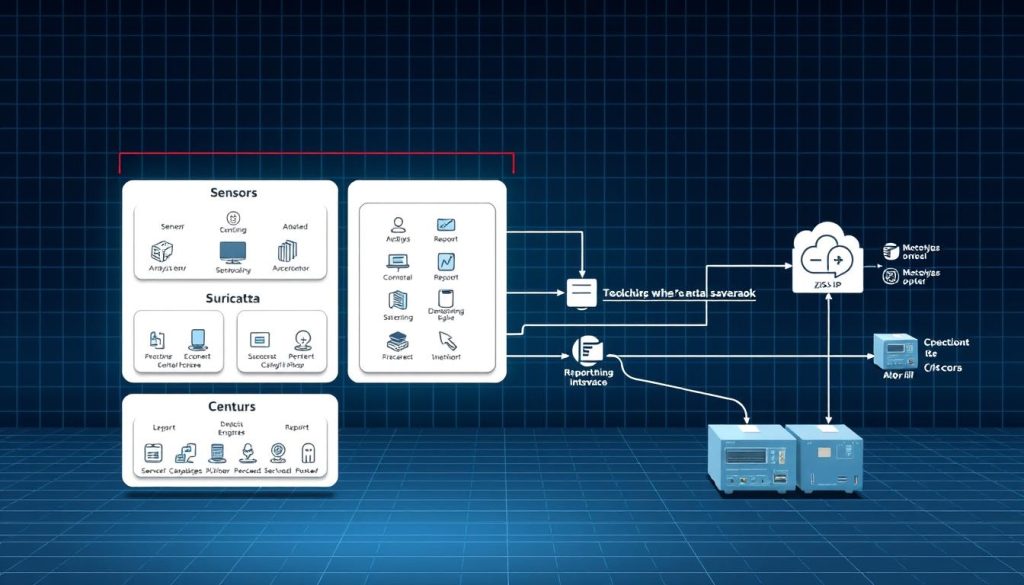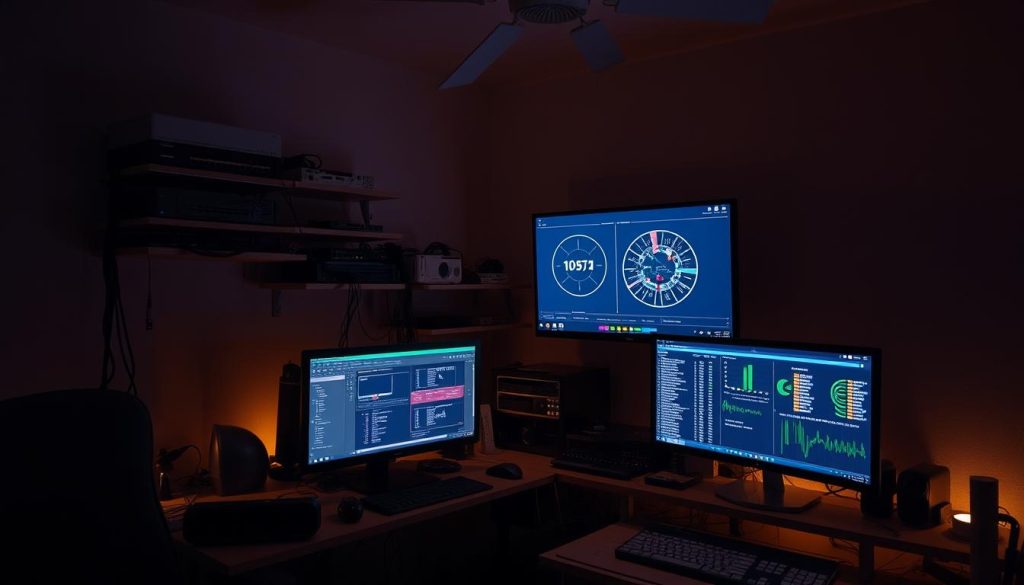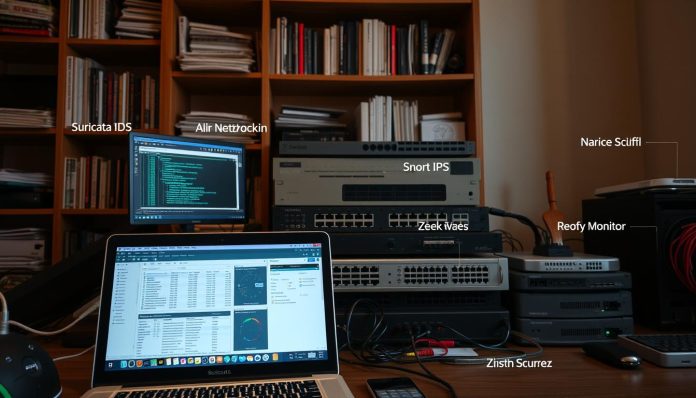Bring enterprise-grade network security to your house without license fees. This introduction explains how three popular free tools differ, and why homeowners may want visibility, alerts, or active blocking on their local network.
Signature-based options match traffic to rules for rapid detection and optional inline blocking, while passive analyzers record communications for deep forensic analysis. Expect trade-offs: live blocking can stop threats but adds complexity, while passive logging keeps your router path simple.
Benefits include transparent code, strong community rule feeds, and customizable rules and scripts that suit modest hardware. Plan for CPU, memory, and storage when you collect packet data or rich logs.
Key Takeaways
- Free tools give visibility and active protection options for home networks.
- Signature matchers handle real-time detection; passive analyzers focus on logs and analysis.
- Use passive monitoring first, then consider inline setups once tuned.
- Community rule feeds speed setup but require tuning to reduce noisy alerts.
- Balance hardware needs: CPU, memory, and storage affect performance and logging.
What an Open-Source IDS/IPS Can Do for Your Home Network Today
Decide if you need live blocking of risky traffic or deep logs that reveal device behavior over time. That choice shapes which security features you enable and how intrusive the setup will be.
User intent and scope: real-time protection vs. visibility
If your goal is to stop risky connections as they happen, choose systems that can interrupt traffic inline. These offer immediate protection but carry some risk of accidental outages when rules are too strict.
If you want to understand what devices do, passive monitoring gives rich context. Passive tools collect metadata, create detailed logs, and help with threat detection without touching live traffic.
Signature-based vs. anomaly/behavior-based detection in plain terms
Signature-based detection uses known fingerprints from rules to flag malicious activity quickly. This approach yields fewer false positives and catches established attacks fast.
Anomaly analysis learns normal traffic patterns and alerts on deviations like odd destinations or unusual volumes. It can spot novel threats but often needs tuning to reduce noise.
Best practice: run baseline rule feeds for broad coverage and add selective behavior analysis for high-value devices. Combine both to balance detection and minimal disruption.
Snort, Suricata, and Zeek at a Glance: Core Approaches and Architectures
Different engines parse packets and record activity in distinct ways — that choice shapes what you can detect. This section summarizes detection models, processing paths, and whether a system blocks traffic or only watches it.
Detection models: Signature-based detection matches known patterns. Both snort suricata and its peers use rules to flag malicious payloads. Suricata adds deep packet inspection and protocol decoders (HTTP, TLS, DNS) for richer conditions. Zeek focuses on traffic analysis and produces metadata for investigation.
Processing paths and architecture: A classic snort design historically favors single-threaded processing, which can limit performance on busy links. Suricata uses native multi-threading to scale across CPU cores. Zeek runs a multi-process, event-driven system that offloads parsing and scripting for large workloads.
Active blocking vs. passive monitoring: Running inline lets some systems act as IPS to drop or reset packets at wire speed. That adds enforcement but also risk of outages if rules misfire. Passive monitoring via SPAN/TAP keeps the network stable while feeding rich logs to SIEMs and hunting workflows.

- Choose DPI and inline features when you need real-time threat detection and enforcement.
- Choose event-driven analysis when you want forensic logs and behavioral visibility.
Suricata vs. Snort vs. Zeek: Strengths, Weaknesses, and Ideal Home Use Cases
Choosing the right packet engine shapes whether your gateway blocks threats or simply logs them for later review.
Suricata offers multi-threaded performance, deep packet inspection, protocol decoding, and file extraction. It can act as an IDS/IPS/NSM with inline actions like drop, reset, and rate-limit. This makes it ideal for small multi-core appliances where both prevention and rich logging matter.
Snort: signature-first, lightweight option
Snort is a long-standing signature-driven system with broad community rule feeds and simple front-ends. It is resource-friendly and fits modest throughput links. Its single-threaded heritage limits peak performance on busy networks, but it remains a solid choice for straightforward intrusion detection and basic threat detection.
Zeek: deep monitoring and forensic logs
Zeek does not block live traffic. It generates detailed HTTP, DNS, and TLS logs and uses an event-driven scripting language for advanced analysis. Expect a steeper learning curve and larger storage needs, but gain forensic-grade context for retrospective hunts and incident response.
“Use Suricata for active prevention and visibility, Snort for simple signature coverage, and Zeek when you need long-term behavioral analysis.”
| Aspect | Suricata | Snort | Zeek |
|---|---|---|---|
| Primary capability | Multi-thread DPI, inline blocking, file extraction | Signature detection, wide community rules | Event-driven monitoring, rich metadata logs |
| Best home use | WAN-edge IPS on small appliances | Lower-power gateways with modest bandwidth | Mirrored port for long-term forensic analysis |
| Learning curve | Moderate: rules and tuning | Low: community rules simplify onboarding | High: scripting skills required |
| Notes on false positives | Tune rules to reduce noisy alerts | Community feeds help but require tuning | Context from logs reduces false positives after enrichment |

- Performance: Suricata scales with cores; Snort suits low-bandwidth links; Zeek needs storage planning.
- Community: Strong rule feeds exist for both snort and snort suricata; Zeek has active script repositories and integrations.
Deploying Open-Source IDS/IPS (Suricata, Snort, Zeek) in a Home Environment
How you place packet inspection—directly on the path or on a mirror port—determines whether threats are stopped or just logged.
Inline IPS vs. SPAN/TAP passive monitoring for home routers
Inline sensors sit on the traffic path so they can drop or reset malicious connections in real time. This gives immediate protection but needs stable hardware and careful rule tuning to avoid accidental outages.
SPAN/TAP setups mirror the WAN or LAN port to feed a copy of traffic for passive monitoring. That approach removes blocking risk and lets you gather rich logs for later analysis and threat detection.
pfSense/OPNsense options: where each tool fits
pfSense/OPNsense offer packages that map to different goals. Install the multi-threaded package for DPI and inline actions when you need prevention and rich application-layer logging.
Choose the lighter signature package for constrained gateways if you want basic intrusion detection and lower CPU use. Add a mirrored port and a separate analysis host when deep NSM logs are required.

Storage, CPU, and memory planning for small form-factor hardware
For typical home bandwidth, 2–4 cores with 4–8 GB RAM handle IDS/IPS duties at good performance. Enabling file extraction, protocol parsers, or heavy DPI will raise CPU and storage needs.
Zeek-style metadata grows fast; plan for external log shipping or larger disks. Test NIC offload and MTU settings, verify fail-open behavior, and document your architecture and interfaces before moving to inline blocking.
| Deployment | When to use | Hardware tips |
|---|---|---|
| Inline sensor | Need real-time blocking and enforcement | Stable appliance, multi-core CPU, low-latency NICs |
| SPAN/TAP mirror | Want safe observation and forensic logs | Separate analysis host, ample storage, log forwarding |
| Hybrid | Block high-confidence rules; mirror for deep analysis | Two interfaces or two devices; automate updates and backups |
- Rollout advice: start passive, validate detections, then enable inline blocking for tuned rules.
- Design note: document interfaces, test fail-open/fail-closed, and balance detection depth with performance.
Rule Sets, Scripts, and Tuning: Reducing False Positives While Catching Real Threats
Keeping signatures current and focused cuts alert fatigue and highlights real threats. Enable community feeds like ET/Open to keep rules fresh for common commodity malware and known exploitation patterns.
Prune noisy categories and enable only what matches typical household traffic — DNS, malware C2, and policy violations. That reduces false positives and makes alerts actionable.
Community feeds and rule management
Schedule automatic updates for community rule feeds so detection stays current without heavy manual work. Review high-volume signatures and suppress or disable those that repeatedly flag benign home devices.
Baseline-driven scripting and log hygiene
Use event-driven scripting to convert raw activity into meaningful signals. Start with default packages, add lightweight policies that track normal destinations, and only escalate on persistent deviations.
| Task | Why it matters | Quick tip |
|---|---|---|
| Enable ET/Open feeds | Rapid coverage of emerging threats | Automate updates and audit monthly |
| Prune noisy rules | Reduces false positives and fatigue | Limit to home-relevant categories |
| Threshold & suppression | Prevents alert storms from repetitive traffic | Document exceptions for future reviews |
| Log hygiene & forwarding | Keeps storage sane and aids analysis | Trim verbose fields; forward to ELK/SIEM |
- Use protocol fields in rules to focus on application-layer indicators rather than broad signatures.
- Review alerts weekly and adjust rules or scripts — tuning is iterative and yields big gains.
Performance and Visibility Trade-offs in a Home Network
Home networks with many streaming devices push DPI engines harder, forcing trade-offs between depth of visibility and sustained throughput. Decide whether you need deep protocol analysis or steady, low-latency performance. That choice affects CPU, storage, and how much data you retain for later analysis.

Traffic volume, encrypted traffic, and DPI considerations
Higher bandwidth and many active devices increase CPU load for packet parsing and protocol decoders. Multi-threaded systems offer better performance under load but use more processor cycles.
Encrypted traffic limits payload inspection. Use metadata like SNI, TLS fingerprints, DNS patterns, and timing to detect threats without decrypting user data.
Turn off nonessential decoders or apply capture filters when the sensor shows packet drops. That prevents missed events caused by overload.
Alert fatigue vs. depth of data: finding the right signal-to-noise
Aggressive rule sets can flood dashboards with low-value alerts. Combine high-confidence signatures with a few targeted behavior checks to reduce false positives and keep triage manageable.
Measure outcomes, not just events: track how often alerts lead to real action and tune rules toward detections that consistently help you mitigate risk.
- Suricata-style IDS-only mode with selective logging gives solid detection with moderate storage needs.
- Zeek-style metadata yields forensic depth but requires rotation policies or external indexing to manage logs.
- Start conservative: run for a week, review alert volume and sensor health, then enable extra decoders incrementally.
| Strategy | Visibility | Performance impact |
|---|---|---|
| Selective DPI | Moderate | Low–medium |
| Full protocol decoding | High | High |
| Passive mirror | High | Minimal on router |
Monitor sensor health (CPU, memory, packet drops) and consider offloading inline processing to a small x86 box or using a mirrored port to preserve connectivity during tuning. This lets you balance detection capabilities with stable network performance.
Home-Friendly Deployment Patterns and Tooling Integrations
Start with a simple, test-first setup that lets you validate alerts before enforcing any blocking rules. This staged approach reduces outages and builds trust in your detection signals.
Quick-start path: run the multi-threaded sensor as IDS to collect traffic and alerts. Pair it with a passive analyzer on a mirrored port for deep logs and forensic analysis. Keep this phase to a week or two while you tune rules and scripts.
Centralized logging and dashboards
Send IDS alerts and passive logs to an ELK/SEIM stack for correlation. Use lightweight dashboards that highlight top talkers, DNS anomalies, and new external destinations.
- Hybrid workflow: edge sensor enforces high-confidence rules; passive analyzer keeps long-term metadata for investigations.
- Minimal schema: index timestamp, src/dst, protocol, domain, and JA3-like hashes to save storage but keep useful context.
- Operational tips: use community parsers for EVE JSON and analyzer logs, automate nightly rule updates, and set index lifecycle policies to age old data.
Alert handling: forward alerts to your SIEM, enrich with passive context before investigation, and prioritize only high-impact categories to avoid fatigue. This pattern gives immediate protection and retains the forensic data you need to answer “what happened.”
Decision Guide: Which Tool Fits Your Home Environment Right Now
Let your network size and appetite for rule tuning drive which detection system you run.
Choose Snort for straightforward signature-based detection when you want low overhead and simple integration. It works well on modest gateways and has mature community rules that catch common threats. Snort is a good first step if you prefer alerts over inline enforcement.
Choose Suricata when you need real-time enforcement and protocol-aware DPI. Its multi-threaded architecture scales on small multi-core appliances, letting you drop malicious sessions while keeping useful logs. Use Suricata if you want both prevention and detailed traffic analysis.
Choose Zeek if long-term behavioral analysis and rich forensic logs matter most. Zeek’s event-driven scripting yields deep context for threat hunting, though it does not block traffic. It is ideal where visibility and post-incident analysis outweigh inline control.
- Weigh features vs. needs: pick signature-only for known threats, multi-threaded enforcement for blocking, or event-driven logging for investigation.
- Consider performance: single-threaded systems can bottleneck; multi-core or multi-process designs use more memory and storage.
- Operational fit: choose the workflow you can maintain—rule tuning is easier; scripting yields more power but takes time.
Conclusion
, Conclusion
Choose tools that match your needs and skill time. For many households, lightweight signature systems give quick detection and low overhead. Multi-threaded DPI setups add active control over malicious traffic while passive analyzers create rich logs for forensic analysis.
Start passively to learn traffic patterns and lower the learning curve. Tune rules and suppress noise before you enable selective blocking. Use community feeds and regular updates to keep detection current.
Outcome: with right-sized hardware and retention policies, you improve your security posture, detect threats faster, and keep alerts actionable. Pick the tool that fits today, iterate over time, and keep your network defenses practical and sustainable.

